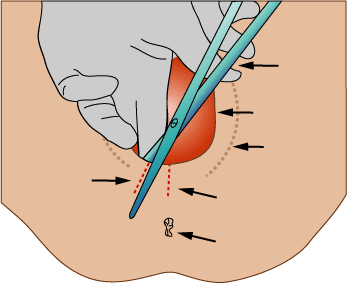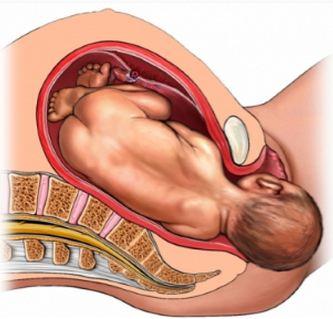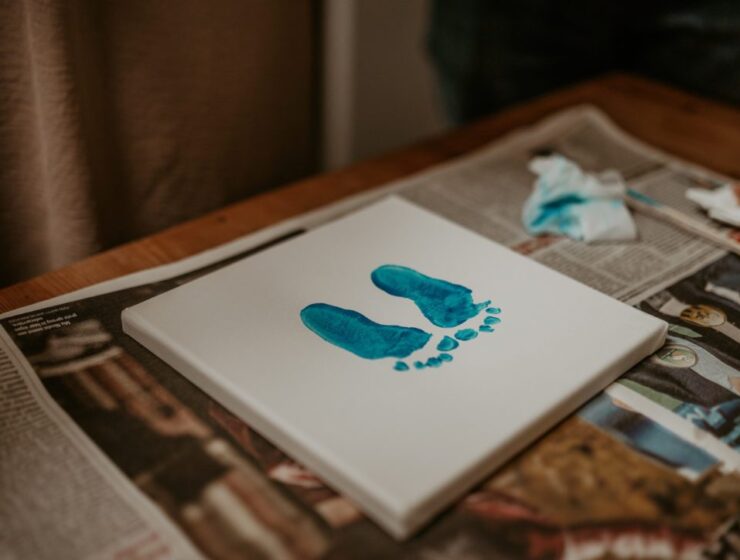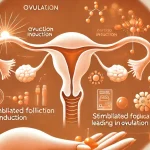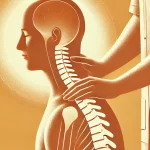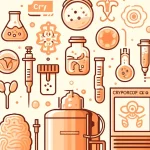Are you also someone who wants to know everything about your birth and the possible interventions that may be involved? Then you've come to the right place! We at Midwives Lelystad know better than anyone that the run-up to the birth of your little one can be exciting. It is a time full of expectations, hopes and yes, also some worries here and there. A topic that often raises questions is the episiotomy, better known as the cut. Many expectant mothers have heard about this, but what does it really mean? And when exactly is it applied?
In this article we dive deep into the world of episiotomy during childbirth. Wewill take you through what exactly it is, when it is being considered, how the recovery process works and of course we will give you tips for the period after the procedure. Our goal is to provide you with all the information you need to prepare for your birth experience. This way you can face this special period with confidence and calmness.
What exactly is an episiotomy and when is it used?
An episiotomy, often referred to as a 'cut', is a procedure in which a small incision is made between the vagina and the anus (the perineum) to enlarge the vaginal opening for the purpose of childbirth. This procedure is not performed routinely. carried out, but may be necessary in certain situations to enable a quick delivery or to prevent serious ruptures. The decision to perform an episiotomy is made by the midwife or doctor, often during the birth itself, depending on how the labor is progressing and the condition of the mother and child.
When is an episiotomy performed? Thereare specific situations where an episiotomy may be considered:
-
- If the baby needs to be born very quickly, for example due to fetal distress.
-
- When there is a breech position or other abnormal positions that require extra space.
-
- When using aids such as a vacuum pump or forceps (forceps).
-
- When the mother is exhausted and can no longer push effectively.
-
- For women giving birth to their first child, which can reduce the risk of serious natural cracks.
Although it is a common procedure, it is no longer routinely performed thanks to better research showing that natural recovery is often preferable. The focus is now more on prevention and supporting a natural process in which the perineum remains intact.
The pros and cons of making an incision during childbirth
When you are about to give birth, the term 'episiotomy' or 'cutting' may come up as an option to facilitate the birth. But what exactly does this mean and what are its pros and cons? In short, an episiotomy involves making a small incision in the perineum - the area between the vagina and the anus - to create more space for the baby to be born. Let's take a closer look at the advantages and disadvantages of this procedure.
Advantages:
-
- Faster birth: An episiotomy can help speed birth if the baby needs to be delivered quickly due to fetal distress.
-
- Less pressure and tearing: Making a controlled cut can sometimes prevent more serious tears from developing that can cause more complications during recovery.
Cons:
-
- Pain after childbirth: Recovery from an episiotomy can be painful and healing can take several weeks, causing discomfort when sitting or walking.
-
- Risk of infections: As with any incision, there is a chance of infections that can complicate and prolong the recovery period.
| Benefit | Disadvantage |
|---|---|
| Less risk of serious cracks | Pain and recovery time after childbirth |
| Can promote a faster birth | Risk of infections |
The decision whether or not to have an episiotomy performed is a personal choice and should be made in consultation with your midwife or doctor. At Midwives Lelystad we approach every birth as a unique experience. Our goal is to support you in making informed decisions that are best for you and your baby, based on your personal situation and preferences.
Pain relief and recovery after an episiotomy
After giving birth, the recovery period from an episiotomy can be challenging. Fortunately, there are several ways to relieve discomfort and promote the healing process. First, it is crucial not to ignore the pain. Consider using pain relief as prescribed by your healthcare provider and keep the wound clean and dry to prevent infections. In addition, applying a cold compress in the first hours after the procedure can help reduce swelling.
-
- Cold compress: Immediately after delivery, a cold compress can be effective to counteract swelling and reduce discomfort.
-
- Sitting on a donut cushion: A donut cushion provides comfort by relieving pressure on the perineum when you sit.
-
- Hygiene: Keep the area clean using a gentle shower or special cleaning sprays recommended by your healthcare provider.
-
- Perineum care: After every visit to the toilet, use a perineum spray or gently rinse the wound with water to prevent infection and support the healing process.
| Activity | Goal |
|---|---|
| Walk softly | Promotes blood circulation and aids healing |
| To drink water | Keeps the urine light and less irritating to the wound area |
| Use of pain medication | Controls pain to rest and move more comfortably |
Furthermore, it is important to take it easy and give your body time to recover. Avoid strenuous exercise and do not lift too heavy. Sufficient rest plays a key role in the healing process. And don't forget: every woman and every birth is unique, so listen carefully to your body and always contact your midwife or healthcare provider if you have any questions or concerns. With the right care and attention, your recovery from an episiotomy will proceed step by step, allowing you to feel like yourself again in no time.
Tips to promote healing and prevent complications
At Midwives Lelystad we think it is important that you are not only fully prepared for your birth, but also for the period that follows, especially if you have had an episiotomy. Good aftercare can significantly improve the healing process and prevent unnecessary complications. Here are some useful tips that we would like to share with you:
-
- Keep the area clean and dry: Hygiene is crucial to prevent infections. Make sure to gently dab the wound area with soft toilet paper after every visit to the toilet or, better yet, rinse with lukewarm water and gently pat dry.
-
- Cold compresses: In the first hours/days after delivery, cold compresses can provide relief to the affected area. This simple but effective method can help reduce swelling and ease pain.
-
- Seating comfort: Finding a comfortable way to sit can be a challenge. Special cushions, such as a donut cushion or an inflatable ring cushion, can reduce pressure on the episiotomy and make sitting more comfortable.
-
- Go to the toilet often: Avoida full bladder as this can increase pressure on the area and cause pain. Try to urinate every 2 to 3 hours, even if you don't feel the urge.
We also recommend taking it easy and giving your body time to recover. It's tempting to want to get back on your feet quickly, especially with your new bundle of joy that needs your attention. but remind yourself that rest is an essential part of the recovery process. Remember that every woman and every situation is unique. If you have any questions or concerns about your recovery, do not hesitate to contact your midwife or GP.
| Activity | Advice |
|---|---|
| To walk | Limit standing and walking for long periods of time in the first few weeks |
| to bathe | Avoid full baths; opt for showering or shallow sitz baths |
| Exercises | Only start pelvic floor exercises after approval from your midwife |
| Sex | Wait until after the follow-up check and when you feel ready |
Remember that it's normal to need recovery time after an episiotomy and it's okay to ask for help. We are here at Midwives Lelystad to support you, whether it concerns physical care or just a listening ear. Your health and well-being are our priority!
Alternatives to episiotomy and decisions surrounding your birth plan
For many women, the thought of an episiotomy – a small incision between the vagina and anus to facilitate childbirth is something they would rather avoid. Fortunately, there are alternatives you can consider and discuss with your healthcare provider to make your birth experience as comfortable as possible. One of the natural methods to avoid episiotomy is perineal massage in the weeks leading up to your due date. This can increase the elasticity of the tissue and reduce the chance of tearing. In addition, it is important to take your time during labor and allow the body to stretch slowly, with the help of controlled breathing techniques and position changes.
Moreover, there are decisions you can make to keep the course of your birth as much in your own hands as possible. Discuss with your obstetrician or gynecologist your desire to avoid an episiotomy and ask about their experience and percentages regarding the procedure. Many women also prefer to have an episiotomy. birth plan to express their preferences, such as positions during labor that can reduce the risk of an episiotomy and the use of natural pain relief methods. The most important thing is that you feel informed and supported, regardless of how your labor goes. .
| Alternative | Description | Advantages |
|---|---|---|
| Perineum massage | Massage technique of the perineum in the run-up to childbirth. | Increases elasticity, reduces the risk of tearing. |
| Breathing techniques | Controlled breathing during contractions and expulsion. | Provides natural pain relief, gives control. |
| Birth plan | Document with preferences and wishes regarding the birth. | Ensure that your wishes are known to the care team. |
Choosing the right approach is a personal decision and should always be done in consultation with your healthcare provider. At Midwives Lelystad we are ready to support you with information, guidance and tailor-made care to make your birth experience as positive as possible. to make it possible.
Conclusion
We hope this article has given you more insight into what an episiotomy entails and when it may be necessary during labor. At Midwives Lelystad, our goal is to make your birth as natural and comfortable as possible. We are ready to answer all your questions and will always provide you with the necessary support.
Remember that every birth is unique and we carefully consider all options to choose the best path for you and your baby. Your well-being and that of your child are our top priority. So don't hesitate to contact us during your check-ups if you have any questions or concerns about an episiotomy or other aspects of childbirth.

